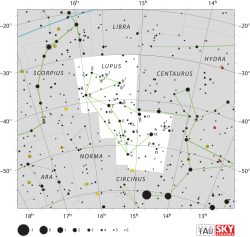Rho Lupi
| Rho Lupi (ρ) | |
 | |
| Observationsdata Epok: J2000 | |
|---|---|
| Stjärnbild | Vargen |
| Rektascension | 14t 37m 53,22583s[1] |
| Deklination | -49° 25′ 32,9798″[1] |
| Skenbar magnitud () | 4,05[2] |
| Stjärntyp | |
| Spektraltyp | B3/4 V[3] |
| U–B | -0,56[2] |
| B–V | -0,15[2] |
| Astrometri | |
| Radialhastighet () | +8,00 ± 7,40[4] km/s |
| Egenrörelse (µ) | RA: -28,26[1] mas/år Dek.: -28,82[1] mas/år |
| Parallax () | 10,32 ± 0,16[1] |
| Avstånd | 316 ± 5 lå (97 ± 2 pc) |
| Absolut magnitud () | -0,88[5] |
| Detaljer | |
| Massa | 4,66 ± 0,2[6] M☉ |
| Radie | 3,4[7] R☉ |
| Luminositet | 365[8] L☉ |
| Temperatur | 15 947 ± 542[6] K |
| Vinkelhastighet | 166[6] km/s |
| Ålder | 44 ± [6] miljoner år |
| Andra beteckningar | |
| ρ Lup, CD-48° 9198, FK5 3158, HD 128345, HIP 71536, HR 5453, SAO 225071[9]. | |
Rho Lupi (ρ Lupi, förkortad Rho Lup, ρ Lup), som är stjärnans Bayer-beteckning, är en ensam stjärna[10] i västra delen av stjärnbilden Vargen. Den har en skenbar magnitud av 4,05[2] och är synlig för blotta ögat där ljusföroreningar ej förekommer. Baserat på parallaxmätning inom Hipparcosuppdraget på ca 10,3 mas,[1] beräknas den befinna sig på ett avstånd av ca 316 ljusår (97 parsek) från solen. Den ingår i undergruppen Upper Centaurus Lupus inom den närliggande Scorpius-Centaurus-föreningen.[11]
Egenskaper
[redigera | redigera wikitext]Rho Lupi är en blå till vit stjärna i huvudserien av spektralklass B3/4 V.[3] Den har en massa som är ca 4,7[6] gånger solens massa, en radie som är ca 3,4[7] gånger solens radie och avger ca 365[8] gånger mer energi än solen från dess fotosfär vid en effektiv temperatur på ca 15 900 K.[6]
Rho Lupi är en mikrovariabel med en period på 10,7 timmar och en amplitud på 0,0046 magnitud.[12] Med en ålder av endast 44[6] miljoner år roterar stjärnan snabbt med en projicerad rotationshastighet på 166 km/s.[6] Detta ger stjärnan en något tillplattad form med en ekvatorialradie som uppskattas vara 6 procent större än polarradien.[13]
Referenser
[redigera | redigera wikitext]- Den här artikeln är helt eller delvis baserad på material från engelskspråkiga Wikipedia, 10 februari 2019.
Noter
[redigera | redigera wikitext]- ^ [a b c d e f] van Leeuwen, F. (2007), "Validation of the new Hipparcos reduction", Astronomy and Astrophysics, 474 (2): 653–664, arXiv:0708.1752, Bibcode:2007A&A...474..653V, doi:10.1051/0004-6361:20078357.
- ^ [a b c d] Johnson, H. L.; et al. (1966), "UBVRIJKL photometry of the bright stars", Communications of the Lunar and Planetary Laboratory, 4 (99), Bibcode:1966CoLPL...4...99J.
- ^ [a b] Houk, Nancy (1978), Michigan catalogue of two-dimensional spectral types for the HD stars, 2, Ann Arbor: Dept. of Astronomy, University of Michigan, Bibcode:1978mcts.book.....H.
- ^ de Bruijne, J. H. J.; Eilers, A.-C. (October 2012), "Radial velocities for the HIPPARCOS-Gaia Hundred-Thousand-Proper-Motion project", Astronomy & Astrophysics, 546: 14, arXiv:1208.3048, Bibcode:2012A&A...546A..61D, doi:10.1051/0004-6361/201219219, A61.
- ^ Anderson, E.; Francis, Ch. (2012), "XHIP: An extended hipparcos compilation", Astronomy Letters, 38 (5): 331, arXiv:1108.4971, Bibcode:2012AstL...38..331A, doi:10.1134/S1063773712050015.
- ^ [a b c d e f g h] David, Trevor J.; Hillenbrand, Lynne A. (2015), "The Ages of Early-Type Stars: Strömgren Photometric Methods Calibrated, Validated, Tested, and Applied to Hosts and Prospective Hosts of Directly Imaged Exoplanets", The Astrophysical Journal, 804 (2): 146, arXiv:1501.03154, Bibcode:2015ApJ...804..146D, doi:10.1088/0004-637X/804/2/146.
- ^ [a b] Pasinetti Fracassini, L. E.; et al. (February 2001), "Catalogue of Apparent Diameters and Absolute Radii of Stars (CADARS)", Astronomy and Astrophysics (3rd ed.), 367: 521–524, arXiv:astro-ph/0012289, Bibcode:2001A&A...367..521P, doi:10.1051/0004-6361:20000451.
- ^ [a b] McDonald, I.; et al. (2012), "Fundamental Parameters and Infrared Excesses of Hipparcos Stars", Monthly Notices of the Royal Astronomical Society, 427 (1): 343–57, arXiv:1208.2037, Bibcode:2012MNRAS.427..343M, doi:10.1111/j.1365-2966.2012.21873.x.
- ^ "rho Lup". SIMBAD. Centre de données astronomiques de Strasbourg. Retrieved 2017-03-10.
- ^ <Eggleton, P. P.; Tokovinin, A. A. (September 2008), "A catalogue of multiplicity among bright stellar systems", Monthly Notices of the Royal Astronomical Society, 389 (2): 869–879, arXiv:0806.2878, Bibcode:2008MNRAS.389..869E, doi:10.1111/j.1365-2966.2008.13596.x.
- ^ Chen, Christine H.; et al. (September 2012), "A Spitzer MIPS Study of 2.5-2.0 M⊙ Stars in Scorpius-Centaurus", The Astrophysical Journal, 756 (2): 24, arXiv:1207.3415, Bibcode:2012ApJ...756..133C, doi:10.1088/0004-637X/756/2/133, 133.
- ^ Koen, Chris; Eyer, Laurent (2002), "New periodic variables from the Hipparcos epoch photometry", Monthly Notices of the Royal Astronomical Society, 331: 45, arXiv:astro-ph/0112194, Bibcode:2002MNRAS.331...45K, doi:10.1046/j.1365-8711.2002.05150.x.
- ^ Belle, G. T. (2012), "Interferometric observations of rapidly rotating stars", The Astronomy and Astrophysics Review, 20: 51, arXiv:1204.2572, Bibcode:2012A&ARv..20...51V, doi:10.1007/s00159-012-0051-2.






